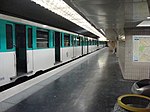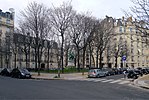The Peninsula Paris

The Peninsula Paris is a historic luxury hotel, originally known as the Hotel Majestic, located on Avenue Kléber in the 16th arrondissement of Paris, France. It opened in 1908 as the Hotel Majestic and was converted to government offices in 1936. The hotel served as a field hospital for wounded officers during World War I, staffed largely by British aristocrats. During World War II, it served as the headquarters of the German military high command in France during the German occupation of Paris. The building played a pivotal role in the deportation of Parisian Jews and the 1944 assassination attempt on Hitler. The building reopened as The Peninsula Paris in August 2014, following a complicated and costly restoration.
Excerpt from the Wikipedia article The Peninsula Paris (License: CC BY-SA 3.0, Authors, Images).The Peninsula Paris
Avenue Kléber, Paris 16th Arrondissement (Paris)
Geographical coordinates (GPS) Address Nearby Places Show on map
Geographical coordinates (GPS)
| Latitude | Longitude |
|---|---|
| N 48.871 ° | E 2.2933 ° |
Address
Le Rooftop
Avenue Kléber 19
75116 Paris, 16th Arrondissement (Paris)
Ile-de-France, France
Open on Google Maps










